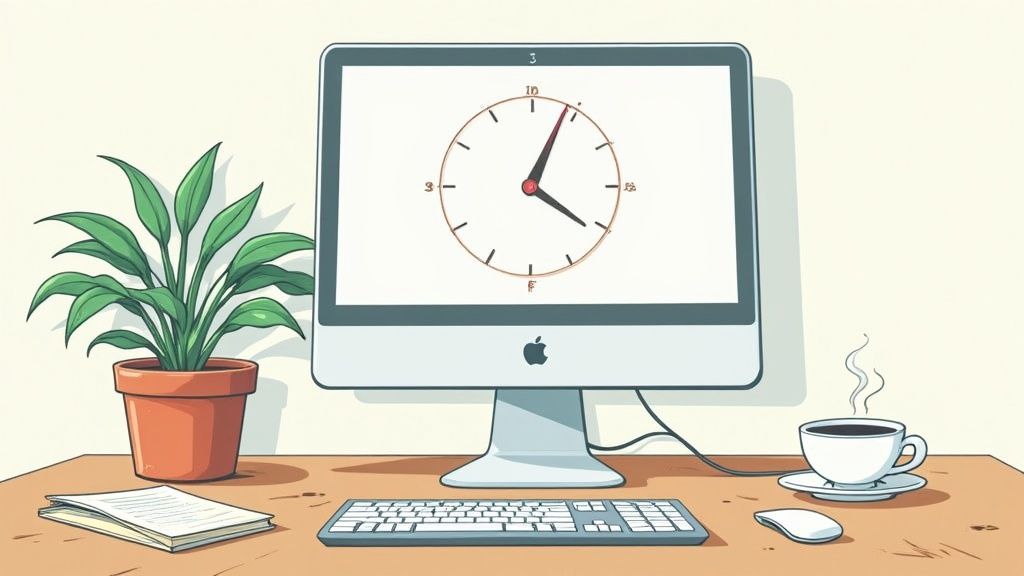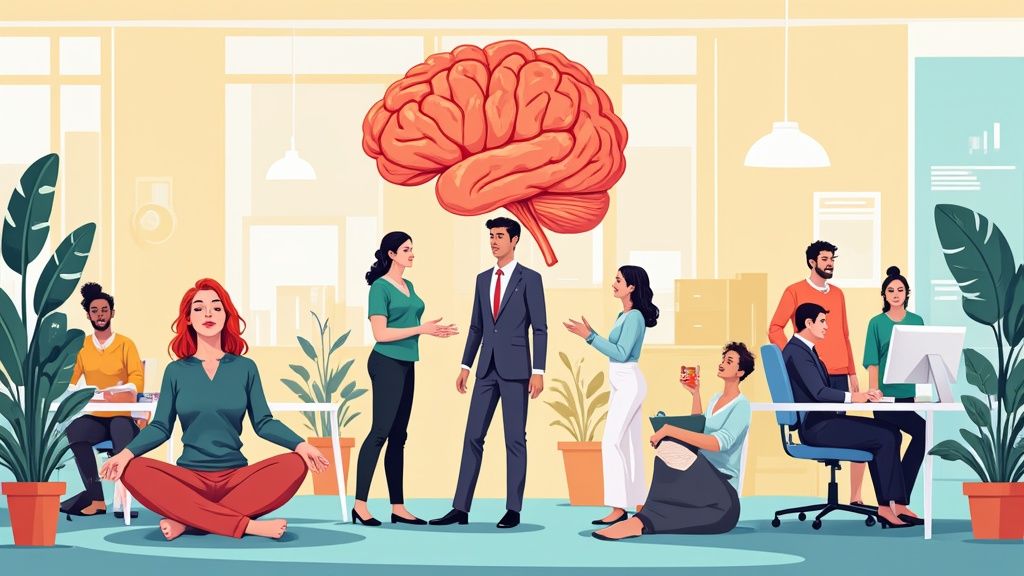The Science Behind Taking Breaks at Work: Transform Your Productivity with Strategic Pauses
Breaking Through Workplace Burnout: Why Pauses Matter

After hours of back-to-back meetings and endless tasks, many of us feel completely drained at work. This constant pressure to produce can actually backfire, leading to lower output and burnout. Yet there's a simple solution that's often overlooked - taking regular breaks throughout the workday. Let's explore why building pauses into your schedule isn't just a nice perk, but essential for both performance and wellbeing.
The Productivity Paradox: Why Rest Boosts Output
The idea that working longer hours means getting more done is a myth. Think of your brain like any other muscle - without proper rest between periods of exertion, it gets fatigued and starts to falter. Research shows that even brief 5-minute breaks can sharpen focus and reduce mistakes. For instance, a study found that employees who took hourly breaks maintained better attention spans compared to those who worked straight through. These short rest periods give your mind the chance to process information and come back refreshed.
Beyond Productivity: The Wider Benefits of Breaks
Regular breaks do more than just boost productivity - they're vital for your overall wellbeing. Taking time to pause helps reduce workplace stress while making you feel more satisfied with your job. Brief breaks also spark creativity by giving your brain space to make new connections. Much like how sleep helps cement memories and learning, stepping away from work allows your mind to digest information in new ways. The mental reset you get from a break often leads to better problem-solving when you return to tasks.
The Psychology of Resistance: Why We Avoid Breaks
Many of us feel guilty about taking breaks, worrying we'll fall behind or appear lazy. But this mindset is misguided and ultimately self-defeating. Just as a car needs regular maintenance to run properly, our brains need consistent rest to function well. When we ignore this need, the results are predictable - exhaustion, creative blocks, and even physical health issues. The drive to work nonstop actually makes us less effective over time.
Reframing the Break: From Guilty Pleasure to Strategic Tool
It's time to stop seeing breaks as unnecessary luxuries and recognize them as essential tools for peak performance. Forward-thinking companies understand this and actively encourage employees to take regular pauses throughout the day. When we view breaks as vital productivity enhancers rather than time-wasters, we can tap into our full potential while creating more sustainable work habits. This mindset shift benefits both individual workers and the entire workplace culture.
The Neuroscience of Rest: Your Brain's Hidden Productivity Switch

Taking breaks isn't just about feeling better - it's deeply connected to how our brains work at a biological level. Research shows that rest periods are essential for maintaining peak mental performance. Let's explore the fascinating brain science behind why breaks are crucial for doing our best work.
The Default Mode Network: Your Brain's Idle Engine
Your brain operates in two main states: focused and diffuse thinking. While concentrated work engages your focused mode, scientists have discovered something remarkable about what happens when you take breaks. During these rest periods, your brain's Default Mode Network (DMN) kicks into gear. Rather than shutting down, your brain uses this "idle" time to process memories, make new mental connections, and generate creative insights. Taking breaks gives your DMN the space it needs to work behind the scenes, similar to how your computer needs background processing time to run smoothly.
Neurotransmitters and Fatigue: The Chemical Toll of Non-Stop Work
Working for long stretches without breaks drains important brain chemicals like dopamine and norepinephrine that you need to stay sharp. Think of it like a runner hitting the wall after depleting their energy stores - your brain experiences a similar "crash" when pushed too hard without rest. Over time, this chemical depletion makes it harder to focus and make good decisions. Regular breaks allow these essential neurotransmitters to replenish, helping you return to tasks with renewed mental energy.
Attention Restoration Theory: Replenishing Your Mental Reserves
Research shows that certain types of breaks are especially good at restoring depleted attention spans. Activities that don't require intense focus, particularly those involving nature, help recharge your mental batteries. Simple actions like looking at plants, listening to calming music, or taking short outdoor walks give your brain the reset it needs. These strategic pauses act as a mental refresh button that helps you tackle work with renewed clarity.
Practical Neuroscience: Optimizing Your Breaks for Peak Performance
Understanding how your brain benefits from rest can help you design more effective breaks. Instead of mindlessly scrolling social media, try activities that actively support your brain's recovery:
- Mindful Movement: Brief stretching, yoga poses, or walking gets blood and oxygen flowing to your brain to boost alertness.
- Nature Immersion: Even brief exposure to natural settings or images helps restore attention and reduce mental fatigue.
- Social Connection: Positive interactions with others during breaks enhance mood and lower stress, supporting better brain function.
By taking intentional breaks based on brain science, you're not just resting - you're actively enhancing your mind's capabilities. This shifts breaks from an optional luxury to an essential tool for sustained productivity and creative breakthroughs.
Engineering Your Perfect Break Pattern

We've covered why breaks matter - now let's focus on creating a break schedule that works for you. This isn't about randomly stepping away from work whenever you feel like it. Instead, it's about thoughtfully planning short pauses throughout your day to maintain your energy and prevent burnout. The key is making breaks an intentional part of your routine rather than only taking them when you're already exhausted.
Exploring Popular Break Patterns: Finding What Fits
One well-known approach is the 52/17 rule - work for 52 minutes, then take a 17-minute break. This method aligns with your brain's natural rhythms of focus and rest. For instance, after writing intensely for 52 minutes, you might spend your 17-minute break taking a walk, listening to music, or chatting with coworkers. But since everyone works differently, this exact timing may not suit you. The important thing is to test different patterns and discover what helps you stay most productive.
Micro-Breaks: Small Pauses, Big Impact
Taking frequent micro-breaks of just 1-3 minutes can make a real difference in your focus and energy. Something as simple as a 60-second stretch or looking out the window every half hour prevents mental fatigue from building up. These tiny breaks are easy to fit into even packed schedules, making them perfect for busy professionals. Most importantly, they help you avoid the exhaustion that often leads to longer, unplanned breaks later in the day.
Customizing Your Break Pattern: A Personalized Approach
Finding your ideal break schedule requires paying attention to your own rhythms and energy patterns. Notice when you naturally feel most focused and when you start getting tired. Use these observations to plan your breaks - for example, if you tend to hit a wall mid-morning, schedule a slightly longer break then. There's no one-size-fits-all solution here - what refreshes one person may not work for another.
Troubleshooting Common Break Challenges
Starting a new break routine isn't always smooth sailing. You might struggle to disconnect from work or feel guilty about taking time for yourself. One effective solution is setting clear physical and mental boundaries - close your laptop and physically move away from your workspace during breaks. Remind yourself that breaks aren't a distraction but rather an investment in your productivity and wellbeing. By addressing these challenges head-on, you can build sustainable break habits that boost both your performance and overall work satisfaction.
High-Impact Break Activities That Supercharge Recovery

The secret to making breaks count lies in choosing the right activities. While any pause from work provides some benefit, research shows that certain break activities are much better at helping us recharge and refocus. Let's explore proven ways to make the most of your breaks, even if you only have a few minutes.
Moving Beyond the Screen: Active Breaks for Body and Mind
Most of us instinctively reach for our phones during breaks to scroll social media or check emails. But these passive activities often leave us feeling drained rather than refreshed. Instead, try getting your body moving. A quick walk around the office or even some simple stretches can work wonders for your energy and focus. Physical activity increases blood flow to your brain, delivering oxygen and nutrients that help you think more clearly. For example, taking a five-minute walk outdoors will do more to recharge you than spending that same time browsing your phone.
Nature's Rx: The Restorative Power of the Outdoors
Research consistently shows that spending break time in nature, even briefly, helps restore mental focus and reduce stress levels. Whether you visit a nearby park or simply step outside to look at some trees and plants, natural settings have a unique ability to calm our minds and help us reset. The sunlight exposure during outdoor breaks has additional benefits - it helps regulate your body's internal clock and boosts vitamin D levels. Try to incorporate some outdoor time into at least one of your daily breaks.
The Social Connection: Breaks for Building Bonds
Taking breaks with coworkers can be a powerful way to recharge while strengthening workplace relationships. Having genuine conversations and sharing experiences helps create a more positive work environment. However, be mindful that not all social interactions are equally beneficial during breaks. Focus on uplifting discussions rather than office gossip or complaints, which can increase stress. The key is finding the right balance between socializing and giving your mind space to truly rest.
Personalized Breaks: Tailoring Your Time for Maximum Impact
The most effective breaks align with your individual needs and preferences. Pay attention to which activities leave you feeling most energized and refreshed. Do you recharge better with quiet solitude or lively conversation? Does moving your body invigorate you or help you relax? Try different break activities and notice their effects on your mood and focus. For busy professionals, using an app like Moova can help by providing customized 3-minute exercises that fight the effects of sitting all day. Find what works best for you and make those activities a regular part of your break routine.
Building Social Connection Through Strategic Breaks
Taking regular breaks at work helps boost individual performance, but their real power lies in building stronger social bonds. Although personal downtime is essential, making time to connect with coworkers during breaks can help teams work better together, spark new ideas, and create a more positive work environment.
The Power of Social Pauses: Weaving Connections in the Workday
Chatting with colleagues over short breaks gives us chances to get to know each other beyond just work tasks. A casual conversation by the coffee machine can help us understand our teammates' perspectives and work styles better. This helps teams communicate more openly and work together more smoothly. Those small daily interactions build trust and make people feel more connected to their team.
Balancing Social and Solo Time: Finding the Right Mix
While socializing during breaks is valuable, it's important to also have quiet time to recharge. For introverts especially, too much social interaction can be draining rather than energizing. Like having a balanced diet, your break schedule needs both social time and solo reflection time. Some people need more alone time than others, so pay attention to what helps you feel refreshed and ready to work again.
Structured Social Breaks: Boosting Team Dynamics
Many organizations now build social breaks into their workday because they see how it improves team performance. This could mean scheduled team lunches, coffee breaks, or fun group activities like quick games or walks. Having dedicated times for casual interaction helps break down barriers between team members. Better workplace relationships mean smoother collaboration and higher job satisfaction.
Strategies for Introverts and Extroverts: Making Social Breaks Work for Everyone
Both introverts and extroverts can benefit from social breaks, but may need different approaches. While extroverts often enjoy larger group settings, introverts may prefer catching up with just one or two close colleagues. Small group conversations let introverts build meaningful connections without feeling overwhelmed. Meanwhile, extroverts can use their natural social skills to help create a welcoming break environment for everyone.
Maximizing Social Breaks: Practical Tips for Implementation
Here are some simple ways to add social connection into your workday breaks:
- Scheduled Coffee Breaks: Set regular times for team coffee breaks focused on non-work conversation
- Walking Meetings: Turn one-on-one meetings into short walks for more natural discussion
- Team Lunches: Plan occasional team lunches to build relationships outside of work tasks
- Break Room Setup: Create inviting break spaces with comfortable seating for group conversation
By thoughtfully integrating social breaks into your workday, you can turn routine pauses into opportunities for building stronger workplace relationships. This recognizes that breaks aren't just about individual rest - they're chances to create the supportive work community that helps everyone succeed together.
Creating a Break-Positive Culture That Drives Results
Taking breaks at work isn't just a nice perk anymore - research shows that breaks are essential for maintaining productivity and employee wellbeing. However, just allowing breaks isn't enough. Organizations need to actively promote and celebrate breaks as a key driver of success. Let's explore how to build a workplace culture that fully embraces the power of breaks.
Overcoming Resistance to Breaks: Addressing Concerns and Shifting Mindsets
Many employees and managers still view breaks as a sign of laziness or lost productivity. This mindset often runs deep in workplace cultures and can be challenging to change. The key is using concrete evidence to shift these perceptions. For example, studies consistently show that regular breaks lead to better focus, fewer errors, and higher output compared to non-stop work. Sharing success stories from companies that have embraced breaks, like Google and Microsoft, helps demonstrate their real business impact.
Implementing Break-Friendly Policies: Walking the Talk
Moving beyond mindset shifts requires putting supportive policies into practice. Simple changes like scheduling regular team breaks or encouraging walking meetings help normalize stepping away from work. When managers openly take breaks themselves, it sends a clear message that breaks are valued and expected. Building breaks into the workday structure, rather than treating them as optional, makes them part of the organizational DNA.
Measuring the Impact of Break Initiatives: Demonstrating ROI
To gain widespread support for break-positive practices, organizations need clear data showing their value. Track key metrics like employee engagement scores, productivity levels, and stress-related absences before and after implementing break programs. For instance, if employee surveys reveal a 30% boost in afternoon focus after introducing scheduled break times, that provides compelling evidence for continuing and expanding these initiatives.
Building Sustainable Support: Engaging Employees at All Levels
Creating lasting change requires active participation across the organization. Empower employees to champion breaks by providing education on stress management and the science behind breaks. Form wellness committees led by staff to develop and promote break initiatives. When employees understand the "why" behind breaks and have ownership over break practices, they become invested in maintaining a healthier work environment. Even small actions like taking brief Moova exercise breaks can significantly impact energy and focus throughout the day.
Want to transform your workday with short, effective breaks? Try [Moova](https://getmoova.app) today and experience the difference!







